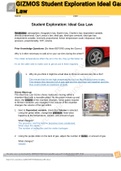2019Name: Date: Student Exploration: Ideal Gas Law
Vocabulary: atmosphere, Avogadro’s law, Boyle’s law, Charles’s law, dependent variable, directly proportional, Gay-Lussac’s law, ideal gas, ideal gas constant, ideal gas law, independent variable, inversely proportional, Kelvin temperature scale, kilopascal, mole, pressure, proportionality, STP, volume Prior Knowledge Questions (Do these BEFORE using the Gizmo.)
Why is it often necessary to add air to your car tires during the winter?
The colder temperatures effect the air in the tire, they go flat faster so it’s on the safer side to make sure to get air put in them regularly.
1.Why do you think it might be a bad idea to throw an aerosol can into a fire?
The minute they hit too high temperatures such as fire the liquid turns to gas. This means they become full of gas, gas and fire don’t mix well together and this thus could create an explosion of sorts.
Gizmo Warm-up
The Ideal Gas Law Gizmo shows molecules moving within a chamber fitted with a movable piston. As the piston moves up and down, the volume of the chamber changes. Since gases expand to fill their container, any changes in the volume of the chamber changes the volume of the gas within. 1.Next to Dependent variable , check that Volume is selected. Using the green slider, change the pressure. Note what happens to the temperature, volume, and amount of gas.
What changes? The pressure, and the volume becomes more condensed.
What stays the same?
The number of molecules and the moles hydrogen
2.Using the purple slider on the tank of gas, adjust the number of moles, or amount of gas.
What changes?
Volume
This study source was downloaded by 100000828331062 from CourseHero.com on 07-21-2021 01:50:17 GMT -05:00
https://www.coursehero.com/file/61867532/IdealGasLawSE-1docx/This study resource was
shared via CourseHero.com
GIZMOS Student Exploration Ideal Gas
Law 2019What stays the same? Pressure and temperature 3.Now make Pressure the dependent variable. Use the red slider to change the temperature. What changes? The volume skyrockets
What remains the same? Temperature and moles hydrogen
Activity A: Volume relationships Get the Gizmo ready : Select Volume as the dependent variable.
Set Pressure (P) to 1.0 atm, Moles (n) to 1.0, and
Temperature (T) to 100 K.
Introduction: The dependent variable changes in response to a change in the independent variable in an experiment. Independent variables are controlled by the experimenter and are manipulated to see what effect they might have on the dependent variable. Question: What are some factors that affect the volume of a gas? 1.Investigate : In this Gizmo, all temperatures are measured using the Kelvin temperature scale. This scale is based directly on molecular motion, with 0 K equal to –273 °C.
A.What do you think will happen to the speed of the molecules if a gas is heated? They’ll immediately start bouncing around much faster. B.What do you think will happen to the space between molecules, and thus the volume
of a gas, as it is heated? They’re going to start dispersing so they have more room to maneuver.
2.Analyze : Select the TABLE tab to see your data. With temperature set at 100 K, press Record. Increase the temperature in 50 K increments, pressing Record each time.
A.What trend do you see?
The moles slowly start moving around faster. B.If the temperature of a gas is doubled, its volume will increase by 2x
C.If the temperature of a gas is halved, its volume will decrease by 2x.
If two variables are directly proportional , an increase in the independent variable will cause the dependent variable to increase at the same rate. If the variables are This study source was downloaded by 100000828331062 from CourseHero.com on 07-21-2021 01:50:17 GMT -05:00
https://www.coursehero.com/file/61867532/IdealGasLawSE-1docx/This study resource was
shared via CourseHero.com




